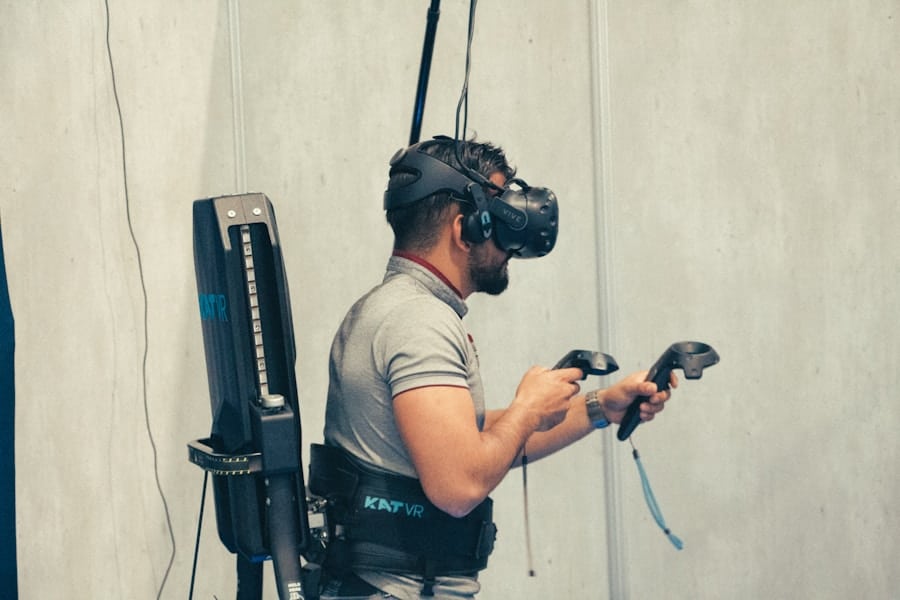In recent years, the fitness industry has undergone a significant transformation, driven by technological advancements and changing consumer preferences. Immersive fitness platforms have emerged as a revolutionary approach to exercise, combining physical activity with engaging digital experiences. These platforms leverage cutting-edge technologies such as virtual reality (VR) and augmented reality (AR) to create environments that motivate users and enhance their workout experiences.
By immersing individuals in interactive settings, these platforms not only make fitness more enjoyable but also cater to a diverse range of fitness levels and preferences. The rise of immersive fitness can be attributed to several factors, including the increasing demand for personalized workout experiences and the growing popularity of gamification in health and wellness. As traditional gym memberships decline in favor of at-home workouts, immersive fitness platforms offer a compelling alternative that blends entertainment with exercise.
This shift is particularly appealing to younger generations who seek engaging and dynamic ways to stay active. As we delve deeper into the role of VR and AR in immersive fitness, it becomes clear that these technologies are not just trends; they represent a fundamental shift in how we approach physical fitness.
Key Takeaways
- Immersive fitness platforms use technology to create engaging and interactive workout experiences for users.
- Virtual reality (VR) enhances immersive fitness by creating simulated environments for users to exercise in.
- Augmented reality (AR) overlays digital elements onto the real world, enhancing the user’s perception of their environment during workouts.
- Immersive fitness platforms offer advantages such as increased motivation, engagement, and a more enjoyable workout experience.
- Challenges and limitations of immersive fitness platforms include high costs, technical issues, and potential safety concerns.
The Role of Virtual Reality (VR) in Immersive Fitness
Virtual reality has revolutionized the way individuals engage with fitness by creating fully immersive environments that transport users to different worlds. In VR fitness applications, users don headsets that block out the real world, allowing them to participate in workouts that feel like adventures. For instance, platforms like Beat Saber and BoxVR have gained popularity by combining rhythm-based gameplay with physical activity, encouraging users to move their bodies in sync with music while engaging in a fun and competitive atmosphere.
This not only makes workouts more enjoyable but also helps users forget they are exercising, leading to longer and more effective sessions. Moreover, VR fitness can cater to various interests and fitness levels. For example, some applications simulate outdoor activities such as cycling through scenic landscapes or climbing mountains, providing an exhilarating experience for those who may not have access to such environments in real life.
Others focus on high-intensity interval training (HIIT) or dance-based workouts, allowing users to choose their preferred style of exercise. The adaptability of VR fitness platforms means that they can appeal to a broad audience, from seasoned athletes looking for new challenges to beginners seeking a fun way to get started on their fitness journey.
The Role of Augmented Reality (AR) in Immersive Fitness

While virtual reality immerses users in entirely new environments, augmented reality enhances the real world by overlaying digital elements onto it. AR technology has found its place in immersive fitness by providing interactive experiences that blend physical activity with digital enhancements. Applications like Pokémon GO have demonstrated the potential of AR in encouraging outdoor activity by gamifying the experience of walking or running.
Users are motivated to explore their surroundings while capturing virtual creatures, effectively turning exercise into an engaging game. In the context of fitness training, AR can provide real-time feedback and guidance. For instance, smart glasses equipped with AR capabilities can project workout instructions or performance metrics directly into a user’s field of vision.
This allows individuals to maintain focus on their movements while receiving valuable information about their form or intensity levels. Additionally, AR can facilitate social interactions by enabling users to compete with friends or join group workouts in a shared augmented space, fostering a sense of community even when participants are physically apart.
Advantages of Immersive Fitness Platforms
The advantages of immersive fitness platforms are manifold, making them an attractive option for many individuals seeking to enhance their workout routines. One of the most significant benefits is the increased motivation that these platforms provide. By transforming exercise into an engaging experience, users are more likely to stick with their fitness regimens.
The gamification elements inherent in many immersive fitness applications—such as rewards, challenges, and leaderboards—encourage users to push their limits and achieve their goals. Another advantage is the accessibility that immersive fitness platforms offer. With the ability to work out from home or any location equipped with the necessary technology, users can fit exercise into their schedules more easily than ever before.
This flexibility is particularly beneficial for those with busy lifestyles or limited access to traditional gyms. Furthermore, immersive fitness platforms often provide a wide range of workout options tailored to different skill levels and preferences, ensuring that everyone can find something that suits their needs. This inclusivity fosters a sense of belonging within the fitness community, as individuals from diverse backgrounds come together through shared experiences.
Challenges and Limitations of Immersive Fitness Platforms
Despite their numerous advantages, immersive fitness platforms also face several challenges and limitations that must be addressed for widespread adoption. One significant concern is the cost associated with the necessary technology. High-quality VR headsets and AR devices can be expensive, potentially limiting access for some individuals.
While prices have been decreasing over time, the initial investment may still deter potential users who are unsure about committing to a new fitness routine. Additionally, there are concerns regarding user safety while engaging in immersive fitness experiences. The immersive nature of VR can lead to disorientation or motion sickness for some individuals, particularly during high-intensity workouts or prolonged sessions.
Developers must prioritize user safety by incorporating features that allow for breaks or gradual acclimatization to the virtual environment. Furthermore, as users become engrossed in their digital experiences, they may inadvertently neglect their surroundings, leading to accidents or injuries.
The Future of Immersive Fitness Platforms

Enhancing the Workout Experience
As VR and AR technologies become more sophisticated and accessible, we can expect even more innovative applications that enhance the workout experience. For instance, advancements in haptic feedback technology could allow users to feel physical sensations during workouts, further blurring the lines between virtual and real-world experiences. This could lead to more realistic simulations of activities such as rock climbing or martial arts training.
Personalizing Workout Experiences with AI
The integration of artificial intelligence (AI) into immersive fitness platforms could personalize workout experiences even further. AI algorithms could analyze user performance data and adapt workouts in real-time based on individual progress and preferences.
Optimizing Results with Customized Workouts
This level of customization would not only enhance user engagement but also optimize results by ensuring that workouts are tailored to each person’s unique needs and goals.
Potential Impact on the Fitness Industry
The rise of immersive fitness platforms has the potential to reshape the entire fitness industry landscape. Traditional gyms may need to adapt by incorporating technology-driven experiences into their offerings or risk losing members who prefer the convenience and excitement of at-home workouts. As more individuals gravitate toward immersive fitness solutions, gym owners may find themselves competing not only with other local facilities but also with digital platforms that provide unique and engaging experiences.
Furthermore, the emergence of immersive fitness could lead to new business models within the industry. For example, subscription-based services offering access to a library of VR and AR workouts may become increasingly popular as consumers seek flexibility and variety in their exercise routines. Additionally, partnerships between technology companies and fitness brands could result in innovative products that enhance the immersive experience, such as smart wearables that track performance metrics while users engage in virtual workouts.
Conclusion and Recommendations for Immersive Fitness Platforms
As immersive fitness platforms continue to evolve and gain traction within the health and wellness sector, it is essential for developers and industry stakeholders to prioritize user experience and safety while addressing potential barriers to entry. Offering affordable options for accessing technology will be crucial in ensuring that these platforms reach a broader audience. Additionally, incorporating features that promote user safety—such as customizable settings for intensity levels or built-in breaks—will help mitigate concerns related to motion sickness or disorientation.
Furthermore, fostering community engagement through social features can enhance user retention and satisfaction.
As we look ahead, it is clear that immersive fitness has the potential not only to transform individual workout experiences but also to redefine the future of the entire fitness industry.
If you are interested in enhancing your content creation process, you may want to check out this article on NeuronWriter SEO NLP optimization. It provides valuable insights on how to boost your content with advanced tools and techniques. Additionally, if you are in need of a reliable laptop for graphic design work, you can explore this article on the best laptops for graphic design in 2023. And if you are considering investing in a new Chromebook, you may find this article on the Samsung Galaxy Chromebook 2 helpful in making an informed decision.
FAQs
What is immersive fitness?
Immersive fitness refers to a workout experience that incorporates virtual reality (VR) and augmented reality (AR) technology to create a more engaging and interactive environment for users.
How do VR and AR enhance the fitness experience?
VR and AR technology can transport users to virtual environments, allowing them to feel fully immersed in their workout. This can make exercise more enjoyable and motivating, leading to increased engagement and better results.
What are some examples of immersive fitness platforms using VR and AR?
Some examples of immersive fitness platforms using VR and AR include Supernatural, Black Box VR, and Holofit. These platforms offer a variety of workouts and experiences designed to make exercise more immersive and enjoyable.
What are the potential benefits of using VR and AR for fitness?
The potential benefits of using VR and AR for fitness include increased motivation, improved focus, enhanced enjoyment of exercise, and the ability to access a wide range of virtual environments and workout experiences.
Are there any drawbacks to using VR and AR for fitness?
Some potential drawbacks of using VR and AR for fitness include the cost of the technology, the need for specialized equipment, and the potential for motion sickness or discomfort in some users. Additionally, not all fitness activities may be suitable for VR or AR integration.

